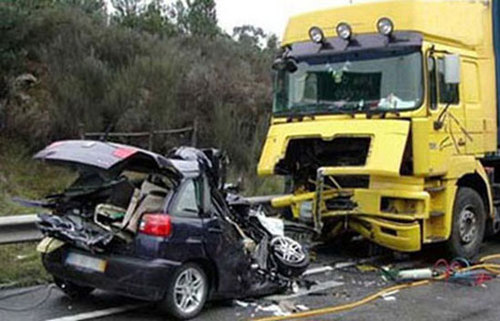Crash and Whiplash
 Injuries from traffic accidents are classified as
acceleration-deceleration injuries
. The more abrupt change in acceleration the driver experiences, the more likely he/she gets hurt. A simple example of this is that when an 18-wheeler (of mass 20 tons) and a compact car (of mass 1.5 tons) both cruising at 15 m/s collide each other head-on, the driver of the compact car is much more liable to serious injury (or even death). If the collision lasted for 100 ms, approximately how much larger was the compact car driver's acceleration than the truck driver's?
Injuries from traffic accidents are classified as
acceleration-deceleration injuries
. The more abrupt change in acceleration the driver experiences, the more likely he/she gets hurt. A simple example of this is that when an 18-wheeler (of mass 20 tons) and a compact car (of mass 1.5 tons) both cruising at 15 m/s collide each other head-on, the driver of the compact car is much more liable to serious injury (or even death). If the collision lasted for 100 ms, approximately how much larger was the compact car driver's acceleration than the truck driver's?
Details and Assumptions
- The collision was perfectly inelastic.
- The impulse force was constant during the collision.
- Ignore any heat energy loss from between the wheels and the road.
- Ignore any deformation of the vehicles.
P.S. Always wear your seat belts!
This section requires Javascript.
You are seeing this because something didn't load right. We suggest you, (a) try
refreshing the page, (b) enabling javascript if it is disabled on your browser and,
finally, (c)
loading the
non-javascript version of this page
. We're sorry about the hassle.
Label the mass of the truck as M , the mass of the car m , the initial velocity of the truck u , the final velocity as v , and the collision time as T .
By conservation of momentum we have M u + m ( − u ) = ( M + m ) v ⇒ v = M + m M − m u .
a = Δ t Δ v
For the car Δ v = u + v ⇒ a c a r = T u + v
and for the truck Δ v = u − v ⇒ a t r u c k = T u − v .
So the difference in acceleration is a c a r − a t r u c k = T 2 v = T ( M + m ) 2 u ( M − m ) .
Substituting in numbers gives 2 5 8 . 1 3 9 . . . ≈ 2 6 0 .